- ON THE DECADE
- THE DECADE'S CAMPAIGN
- REPORTING ON PROGRESS
- THE DECADE'S PROGRAMMES
- FOCUS AREAS
-
- Access to sanitation
- Financing water
- Gender and water
- Human right to water
- Integrated Water Resources Management
- Transboundary waters
- Water and cities
- Water and energy
- Water and food security
- Water and sustainable development
- Water and the green economy
- Water cooperation
- Water quality
- Water scarcity
- FOCUS REGIONS
- RESOURCES FOR
- UN e-RESOURCES
‘Water for Life’ UN-Water Best Practices Award: 2012 edition: Finalists
Category 1
1st ranked: Protection of Bangalore Lakes for Posterity – Setting a Legal Precedent for Conservation of Lakes as Commons
>> More information about the project 'Protection of Bangalore Lakes for Posterity'
2nd ranked: Lake Naivasha Payment for Ecosystem Services Project
Background
The Lake Naivasha basin suffers a problem of heavy soil sedimentation within the Malewa River which is a major cause of massive eutrophication in Lake Naivasha downstream. In fact so grave is the situation that that there are fears that if no urgent remedial action is taken, the lake ecosystem will totally collapse in the next ten years. This would have an unprecedented negative impact on the tourism, horticulture, power generation and fishing industries that rely on the lake waters for their success.
The project
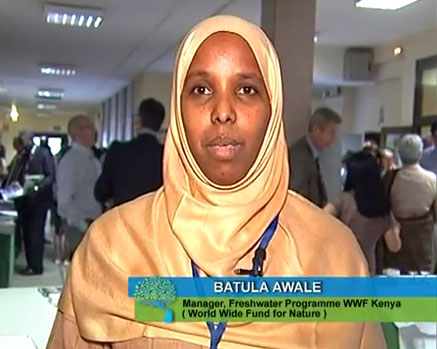 >> Interview with Ms. Batula Awale, Manager, Freshwater Programme, World Wide Fund for Nature (WWF) in Kenya
>> Interview with Ms. Batula Awale, Manager, Freshwater Programme, World Wide Fund for Nature (WWF) in KenyaWorld Wide Fund for Nature (WWF-Kenya Country office) in partnership with CARE-Kenya are piloting a Payment for Ecosystem Services (PES) scheme where downstream communities who benefit from upstream conservation initiatives, reward land owners upstream for voluntarily undertaking conservation measures that reduce silt load in rivers and consequently ensuring availability of clean water downstream. Conservation efforts upstream include rehabilitation and maintenance of riparian zones, establishment of grass strips and terracing along steep slopes, reduction of agro-chemical use and indigenous trees and high yielding fruit trees and cover crops for improved farm productivity expected to result in improved quality and quantity of river water and improve livelihoods. The upstream land managers/owners, who are small scale farmers, are therefore the sellers of the Environmental Service (ES) while the downstream water users are service buyers and consist of economic entities such as flower farms, tourist establishments and government related institutions. The scheme is administered in a mutual agreement in form of legal contract between Water Resource Users (WRUAs) representing both buyers and sellers.
Results achieved
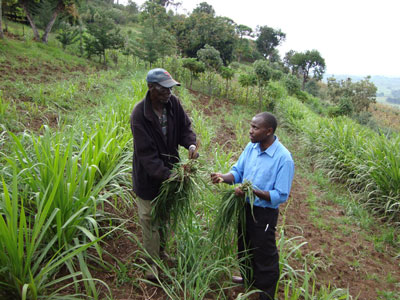 Improved Management Practices: The project has offered various technical and management trainings to farmers, giving them new knowledge and skills while improving others. The farmers have applied the knowledge and skills acquired from the training in improving the way they operate and manage their farm activities. Some of the "most useful" knowledge and skills acquired include river bank protection, planting and management of nappier grass along the contours for soil conservation purposes; fodder preservation and storage among others. Application of the knowledge and skills in the farms has reduced wastage, improved productivity and increased incomes.
Improved Management Practices: The project has offered various technical and management trainings to farmers, giving them new knowledge and skills while improving others. The farmers have applied the knowledge and skills acquired from the training in improving the way they operate and manage their farm activities. Some of the "most useful" knowledge and skills acquired include river bank protection, planting and management of nappier grass along the contours for soil conservation purposes; fodder preservation and storage among others. Application of the knowledge and skills in the farms has reduced wastage, improved productivity and increased incomes.
Improved farm sales: Most of the benefiting farmers have seen an increase in their sales. The improved sales are attributable to the uptake of new/improved crop varieties as well as the adoption of improved farm management practices. While the magnitude of improvement varies across individual farms, they all attribute their improved fortunes to the project. During one Farmer group discussion, farmers reported sales increases of between 20-40%.
Reducing time spent by women in search of fodder: This probably is one of the greatest effects produced on women and children by the project. During a gender session, women reported that by making nappier grass and other fodder crops available on-farm; as well as training farmers to make hay and silage, the project has greatly reduced the amount of time they spend in search of animal feeds, a traditional female role in the community. Women said that prior to this; they spent an average of 8 to 10 hours every week in search of fodder alone. They noted that the freed time is now used in other more productive activities like farm work, business and childcare; while children now have more time to study and play.
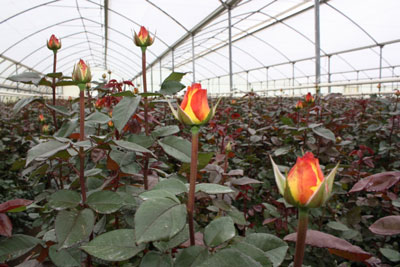 Improved water quality: Indeed this project pilot phase was not designed to make actual impact at this level, but instead to demonstrate the possibility of doing so through PES initiatives. Nonetheless, many of the downstream users believe that it is possible to improve the quality and quantity of water flowing downstream through project activities. In the opinions of many of them, all that is required is a scale up through increasing the number of participating buyers and sellers.
Improved water quality: Indeed this project pilot phase was not designed to make actual impact at this level, but instead to demonstrate the possibility of doing so through PES initiatives. Nonetheless, many of the downstream users believe that it is possible to improve the quality and quantity of water flowing downstream through project activities. In the opinions of many of them, all that is required is a scale up through increasing the number of participating buyers and sellers.
3rd ranked: Bhagirath Krishhak Abhiyan, Water Conservation for Food Security
Background
Though India has only 40% culturable area under irrigation but because of dependency on groundwater for irrigation (80% irrigation was by groundwater) a substantial geographical area has become either grey or dark. Over exploitation of ground has led to loss in productivity and production and in certain cases the complete crop failure. This has resulted into many thousand farmer suicide in India. Similarly Dewas district of Malwa plateau of Madhya Pradesh province also is facing acute water scarcity problems. It has an annual average precipitation of between 900 mm (40 rainy days) which is less than national average. Cropping intensity is only 120% with limited livelihood options and distress migration in the region whose main sufferers are poorest of the poor specially the women. The production and productivity has going down in the region.
The project
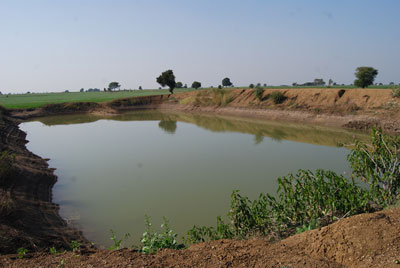 Conscious of the problems of farmers in the region, the district administration led by Mr. Umakant Umrao, who was posted as District Administrator of Dewas in February 2006 stressed on the harvesting of rain water as possibly the only solution to overcome water woes of the district. The administration emphasized on the construction of cost effective and locally managed rainwater harvesting structures.
Conscious of the problems of farmers in the region, the district administration led by Mr. Umakant Umrao, who was posted as District Administrator of Dewas in February 2006 stressed on the harvesting of rain water as possibly the only solution to overcome water woes of the district. The administration emphasized on the construction of cost effective and locally managed rainwater harvesting structures.
Aware of the problems often associated with building, maintaining and managing community water harvesting structures and frequent conflicts over distribution of available water in these structures, the proposed approach emphasized construction of decentralized rain water harvesting structures on the lands of individual farmers with an idea to promote conjunctive use of available water for sustainable and zero risk growth. It was argued that such an approach while helping avoid the problems associated with community water harvesting structures would give the owner farmers complete control over the available water and lead to a more efficient use of the available water. This approach to water harvesting was given the title of "Rewa Sagar".
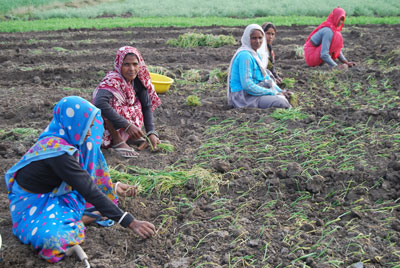 In India the land holding per family is very less and so is the surplus money to invest. In this situation translating the concept in to realistic application posed a great challenge for the administration. One, the farmers have always strongly resisted giving away even a small part of their cultivable land for non cultivation purposes. Two, the administration did not want to use the instrument of giving subsidy to the farmers to either encourage them to invest in water harvesting or to partly meet the upfront cost of construction or as a compensation for the loss in production that the farmers would suffer on account of a part of cultivable land going out of production.
In India the land holding per family is very less and so is the surplus money to invest. In this situation translating the concept in to realistic application posed a great challenge for the administration. One, the farmers have always strongly resisted giving away even a small part of their cultivable land for non cultivation purposes. Two, the administration did not want to use the instrument of giving subsidy to the farmers to either encourage them to invest in water harvesting or to partly meet the upfront cost of construction or as a compensation for the loss in production that the farmers would suffer on account of a part of cultivable land going out of production.
Carefully treading the process of implementation, rather than launching the approach in a big-bang way, the program started in the year 2006 with the district administration approaching initially the relatively bigger farmers (with more than 4 hectares of agricultural land) and in persuading them to change the usage of 1/10th to 1/15th part of their land for water conservation cum harvesting structure which could store runoff water during the monsoons (rainy season) and thereby assure the availability of required water for irrigating during the dry Rabi (Second crop) season. The farmers could also use part of the stored/conserved water for providing life saving irrigation to even Kharif (Rainy season ) crops during the occasional long gaps that may come across between two rainy days during monsoon season as well.
Results achieved
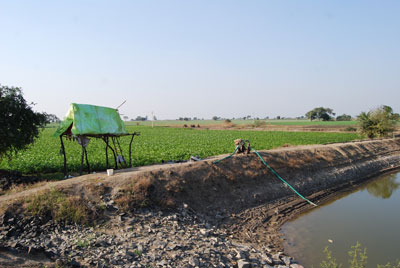 There are now more than six thousand ponds in Dewas district alone, and the number is ever increasing. The impact can be calculated from the fact that total of all irrigation efforts by the Government/Individual since independence brought an additional 3% growth in 50 years with assured irrigation whereas this movement increased such percentage by 12% in 5 years. The effort has won 5 National Awards for augmenting ground and surface water.
There are now more than six thousand ponds in Dewas district alone, and the number is ever increasing. The impact can be calculated from the fact that total of all irrigation efforts by the Government/Individual since independence brought an additional 3% growth in 50 years with assured irrigation whereas this movement increased such percentage by 12% in 5 years. The effort has won 5 National Awards for augmenting ground and surface water.
The Water level which had gone down to 500 to 600 ft in the area has come up significantly. The decentralised surface storage structures have supported the other systems like wells and bore wells and thereby completely mitigating drought in the area in cases of failure of the monsoon.
The practice of digging open wells by small and marginal farmers due to low water level was discontinued long back in Malwa plateau of Madhya Pradesh province. Open wells are now back and 733 wells have been constructed under government scheme since 2007. The small farmers have got back their due.
Agricultural intensity and productivity has increased many times. Entire mandi (Market of Agriculture produce) system has been relocated to facilitate the marketing of produce.
Agriculture has diversified and farming systems have improved and farmers have shifted from Soybeans based mono crop to kharif (First crop), rabi (Second crop), and zaid (Third crop), to multi cropping.
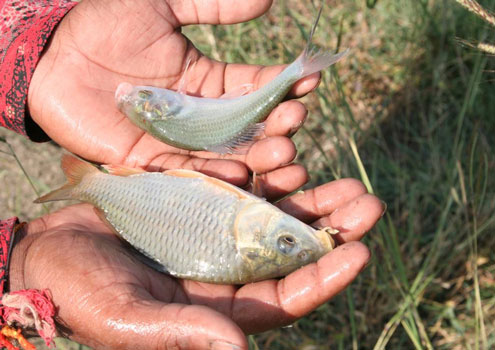 Multiple livelihoods including dairy and fisheries have evolved and the employment days and minimum wages have gone up for the individuals.
Multiple livelihoods including dairy and fisheries have evolved and the employment days and minimum wages have gone up for the individuals.
There is a reduced requirement of fertiliser per unit of agricultural land. Water user efficiency in pond irrigation is more by 30% compared to other types of irrigation.
It has been noted that quality cattle breed has been introduced and milk productivity has increased up to 34% within a short period. Increased availability of vegetables, fish, milk and increased production of food grains has resulted in perceptible change in nutritional levels.
In some cases entire villages have been covered with pond irrigation. The economy has transformed with huge increase in agricultural productivity, multiple livelihood options, and increase in agricultural productivity and number of employment days. For example village Dhaturia in Tonk Khurd has 120 households and 154 ponds.
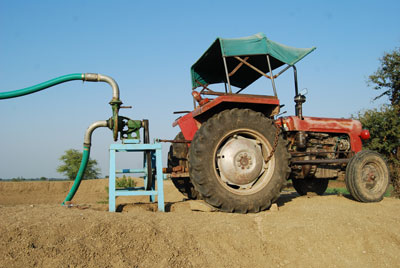 Improved biomass has bettered the quality of livelihood for farming families. The women who earlier suffered from the drudgery of fetching water could now actually contribute to the family's growth. The enrolment ratio in schools has been much better. More over pucca houses have replaced the old kutcha structures.
Improved biomass has bettered the quality of livelihood for farming families. The women who earlier suffered from the drudgery of fetching water could now actually contribute to the family's growth. The enrolment ratio in schools has been much better. More over pucca houses have replaced the old kutcha structures.
The soil conservation efforts have resulted almost hundred percent controls on farm land erosion. The biggest gain, however, was of the enormous wealth added to the Biodiversity with flocks of deer, blackbuck, and several species of birds, insects, reptiles and flora showing presence. The microclimate has changed arresting the extremities of climate.
Category 2
1st ranked: A communication strategy for social and behavior change through the promotion of three key practices and the adequate use of services in four municipalities of the Department of Cochabamba, Bolivia
2nd ranked: Water Project for the populations of the dry tropic in Honduras (in French)
Background
La région du Tropique sec hondurien est une zone aride où les ressources hydriques subissent de fortes pressions. Dans le secteur agricole, on observe une diminution de la quantité d'eau disponible, le niveau de la nappe phréatique baissant de plusieurs mètres au cours de la saison sèche, provoquant l'assèchement des puits de surface. La qualité de l'eau est également problématique en raison de la sédimentation et du rejet de déchets organiques et solides dans les cours d'eau.
Dans la région visée, les précipitations sont inégalement réparties dans le temps, très abondantes entre juillet et septembre, inexistantes entre janvier et avril et très rares pendant le reste de l'année. Cette situation, à laquelle s'ajoute le phénomène d'évapotranspiration des plantes, est la cause principale du stress hydrique vécu par les populations.
Les facteurs énoncés précédemment expliquent les difficultés auxquelles font face les agriculteurs et qui sont à l'origine de l'insécurité alimentaire chronique caractéristique de la région. Les crises alimentaires sont cycliques, saisonnières ou engendrées par des chocs soudains.
La faible productivité des sols, le déboisement, l'utilisation de systèmes de culture inadéquats, la mauvaise gestion de l'eau et l'encadrement technique insuffisant contribuent à augmenter la fréquence et l'intensité de ces crises.
Pour les familles, il devient très ardu de combler leurs besoins alimentaires, et quasi impossible de faire de l'agriculture une activité génératrice de revenus. Ainsi, alors même que la majeure partie de la population de la zone se consacre à l'agriculture traditionnelle et à l'élevage, les revenus des familles participantes sont particulièrement bas comparativement à d'autres régions. Une réalité qui s'explique principalement par la faible productivité de l'activité agricole à laquelle s'ajoute une technologie déficiente.
Le stress hydrique vécu par les populations et leur insécurité alimentaire affectent négativement leur santé. La consommation d'eau contaminée engendre une prévalence importante des maladies hydriques. Les faibles rendements agricoles engendrent quant à eux des carences alimentaires.
The project
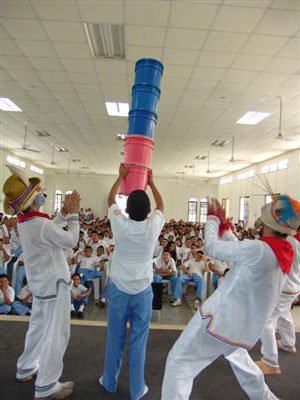 Ce projet se déploie selon une approche «trépied» comprenant trois mesures complémentaires de lutte contre la pauvreté : (1) sensibiliser, mobiliser et éduquer la population par le biais des arts et de la culture, (2) améliorer l'accessibilité, la gestion responsable de l'eau ainsi que l'assainissement et (3) allouer des micro-crédits.
Ce projet se déploie selon une approche «trépied» comprenant trois mesures complémentaires de lutte contre la pauvreté : (1) sensibiliser, mobiliser et éduquer la population par le biais des arts et de la culture, (2) améliorer l'accessibilité, la gestion responsable de l'eau ainsi que l'assainissement et (3) allouer des micro-crédits.
Au Honduras, compte tenu de l'instabilité politique, il s'est avéré impossible de développer le volet microcrédit. Le volet gestion de l'eau comprend plusieurs mesures. D'abord, l'amélioration de l'accès à l'eau par le biais de la protection et/ou l'accès à une source et de la captation de l'eau de pluie (gouttières, citernes). Ensuite, l'aménagement de jardins familiaux (systèmes d'irrigation goutte à goutte) pour cultiver une surface de 20 m2. Les familles sont encouragées à planter des arbres fruitiers et forestiers, résistant aux sécheresses et constituant une source stable de revenus. Le projet comprend aussi la réhabilitation de latrines pour réduire le ruissellement et l'occurrence des maladies hydriques, la distribution de filtres à eau potable et/ou grise pour en assurer la qualité ainsi que la construction d'un four à cuisson éco-énergétique. Ce dernier permet de diminuer la consommation de bois, contribuant à réduire la déforestation ainsi que la fumée à l'intérieur des habitations, à l'origine de problèmes de santé. Les écoles situées à l'intérieur de la zone d'intervention bénéficient également de ce matériel.
Quant au volet pédagogique/artistique, il comprend trois champs d'activités. Dans un premier temps, il s'agit de concevoir, avec les communautés, et de présenter aux communautés bénéficiaires ainsi qu'aux jeunes des écoles environnantes un spectacle multidisciplinaire, itinérant et interactif sur le thème de l'eau. La création artistique permet d'impliquer les populations et de les sensibiliser aux enjeux de l'eau et à l'importance de préserver la ressource. Le volet pédagogique/artistique vient ainsi renforcer le volet gestion de l'eau en ancrant dans l'esprit des communautés l'importance de l'eau pour leur développement.
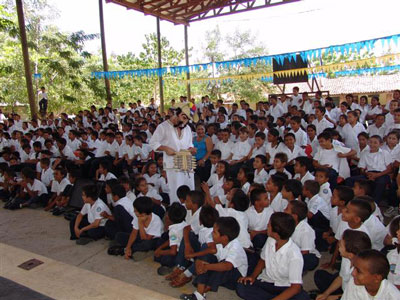 Le projet comprend aussi la réalisation d'ateliers pédagogiques pour les jeunes sur le thème de l'eau à travers le théâtre, le muralisme, la danse, la musique, la radio, les arts du cirque et les marionnettes. Les jeunes leaders de la communauté deviennent ainsi les ambassadeurs de la cause de l'eau en transmettant leur savoir à leur entourage.
Le projet comprend aussi la réalisation d'ateliers pédagogiques pour les jeunes sur le thème de l'eau à travers le théâtre, le muralisme, la danse, la musique, la radio, les arts du cirque et les marionnettes. Les jeunes leaders de la communauté deviennent ainsi les ambassadeurs de la cause de l'eau en transmettant leur savoir à leur entourage.
Finalement, la troisième composante pédagogique/artistique du projet consiste en la publication de guides et autres outils didactiques sur l'eau.
Le projet vise directement 1 350 familles pour un nombre de bénéficiaires total de 9450 personnes. Quant aux activités d'éducation populaire, elles sensibilisent un peu plus de 15 000 personnes.
Le choix des populations ciblées par le projet Honduras favorise la non-discrimination. Ainsi, le projet vise les populations rurales, éloignées et d'accès difficile. Celles-ci sont généralement pauvres, ayant un revenu annuel familial nettement inférieur au salaire minimal agricole établi. De plus, une proportion importante des communautés visées est de descendance autochtone lenka. Ces communautés sont donc souvent marginalisées et exclues des services fournis aux populations semi-urbaines et urbaines. Le projet permet donc d'atténuer leur vulnérabilité ainsi que la discrimination dont elles sont souvent l'objet.
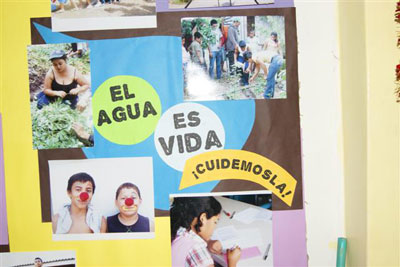 Le projet favorise également l'autonomisation et le renforcement des capacités des femmes, populations souvent vulnérables et sujettes à la discrimination. Puisqu'elles sont traditionnellement responsables de l'entretien de l'espace familial et donc du jardin, les femmes sont activement impliquées dans la mise en oeuvre des activités. Les jeunes sont aussi partie prenante puisqu'ils sont des acteurs de changement visés spécifiquement par le volet artistique.
Le projet favorise également l'autonomisation et le renforcement des capacités des femmes, populations souvent vulnérables et sujettes à la discrimination. Puisqu'elles sont traditionnellement responsables de l'entretien de l'espace familial et donc du jardin, les femmes sont activement impliquées dans la mise en oeuvre des activités. Les jeunes sont aussi partie prenante puisqu'ils sont des acteurs de changement visés spécifiquement par le volet artistique.
Results achieved
Le projet a amélioré la sécurité alimentaire et la situation économique des familles en leur permettant d'accroître leur production agricole. Aussi, la culture des légumes rendue possible grâce aux jardins familiaux a permis la diversification de l'alimentation et l'augmentation de l'apport nutritif, engendrant une amélioration de la santé des bénéficiaires. Ces familles disposent également d'une citerne améliorant sensiblement leur accès à l'eau.
De plus, les filtres à eau ont été distribués aux familles, qui disposent également d'un four à cuisson écoénergétique. Ces bénéficiaires peuvent donc ressentir les impacts positifs, notamment sur leur santé, d'une amélioration de la qualité de l'eau et de l'air à l'intérieur des habitations. En outre, les fours écoénergétiques réduisent le temps consacré à la collecte du bois par les femmes et les filles et/ou réduisent le coût d'achat de ce bois. Le temps et l'argent ainsi libérés peuvent donc être utilisés à d'autres fins.
>> More information about the Water Project for the populations of the dry tropic in Honduras
>> FAQs
>> Statutes
>> Categories
>> Chinese![]()
>> English![]()
>> French![]()
>> Spanish![]()
>> By numbers
>> Candidates
>> Evaluation committee
>> Selection committee
>> Finalists
>> Winners
>> Ceremony
>> By numbers
>> Candidates
>> Evaluation committee
>> Selection committee
>> Finalists
>> Winners
>> Ceremony
>> By numbers
>> Candidates
>> Evaluation committee
>> Selection committee
>> Finalists
>> Winners
>> Ceremony
>> By numbers
>> Candidates
>> Evaluation committee
>> Selection committee
>> Finalists
>> Winners
>> Ceremony
>> By numbers
>> Evaluation committee
>> Selection committee
>> Candidates
>> Finalists
>> Winners
>> Ceremony
Copyright | Terms of use | Privacy notice | Site Index | Fraud alert | Help





